The Taj Mahal, a symbol of enduring love
The Taj Mahal, a symbol of enduring love
The Taj Mahal, a symbol of enduring love
-
Hannah
-
Hannah
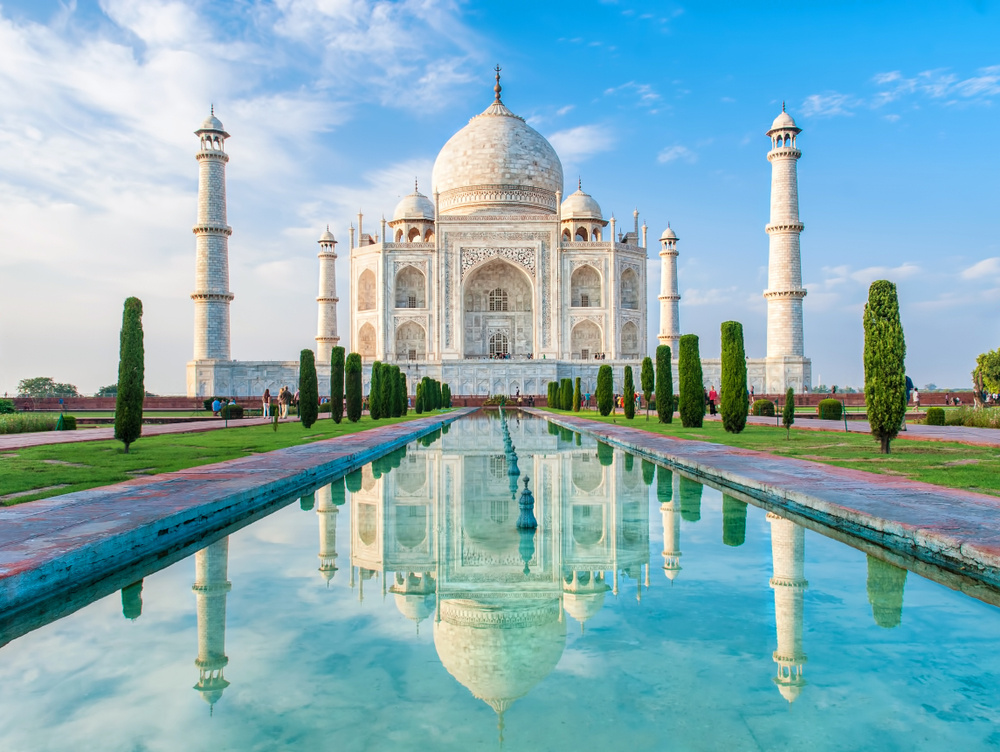
Is this the most beautiful structure ever built? Many believe so. Certainly, the Taj Mahal has become an enduring symbol of India. But its beauty lies not only in its magnificent architecture and stunning white marble, impressive though these doubtlessly are. It is the meaning behind the structure that truly moves people, for the Taj Mahal is a timeless symbol of a husband’s love for his wife.
The monument was built by Shah Jahan, the fifth emperor of the Mughal Empire, who ruled from 1628 to 1658. As was the custom, Shah Jahan had several wives over the course of his adult life, but his favourite by far was Arjumand Banu Begum, known as Mumtaz Mahal.
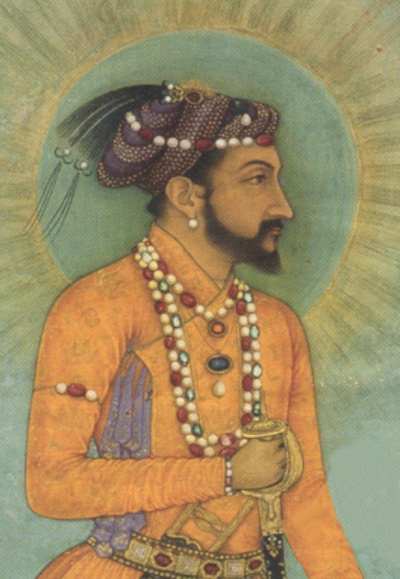
Shah Jahan, from ‘Jujhar Singh Bundela Kneels in Submission to Shah Jahan’, c. 1630
Mumtaz Mahal was of a noble Persian family and her father had attained a powerful position high up in the court of the Emperor Akbar. She was an excellent match for the future emperor Shah Jahan, and they were betrothed to each other in their teens, with a wedding date set five years hence on the advice of court astrologers, in order that the stars would be perfectly aligned for their marriage.
As it turned out, theirs was not simply a union of convenience and the alignment of powerful families. The two fell in love, and Shah Jahan called his wife Mumtaz Mahal, Persian for ‘the exulted one of the Palace’. Though Shah Jahan had other wives, they were nothing but shadows for him beside the brilliant light of Mumtaz Mahal. Over their nineteen-year marriage, the two had a very close bond; Mumtaz Mahal was Shah Jahan’s constant companion, even when he travelled on military campaigns, and he took her advice on all matters.
Once Shah Jahan became emperor, he named her chief empress and bestowed on her the titles Queen of the World and Queen of the Age, among others. He lavished his wife with expensive gifts, from jewellery to land; gave her an unprecedented allowance of a million rupees per year; and had her residence decorated with the finest gold and gems.
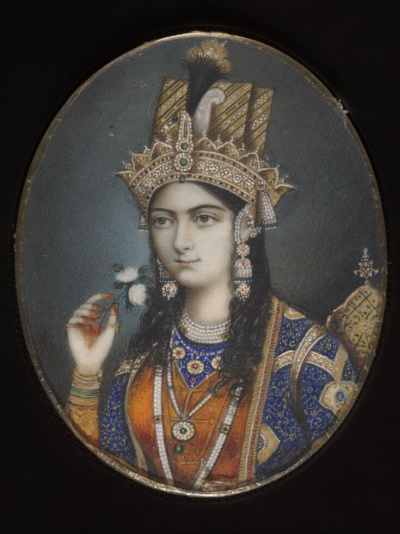
Mumtaz Mahal, c. 1820
Together, Mumtaz Mahal and Shah Jahan had fourteen children – but tragedy struck upon the birth of the final child: Mumtaz Mahal died of a haemorrhage. Distraught, Shah Jahan channelled his grief into a monument that would stand as testament to his undying love for his wife.
It took more than 20,000 masons, labourers and painters to construct the Taj Mahal over 22 years, overseen by a large team of expert architects. It was finally completed in 1653, and Mumtaz Mahal (who had been interred temporarily elsewhere) was laid to rest there. In keeping with the Muslim custom, the crypt and sarcophagus were simple, but above this was built a much more elaborate chamber with a cenotaph (a false sarcophagus).
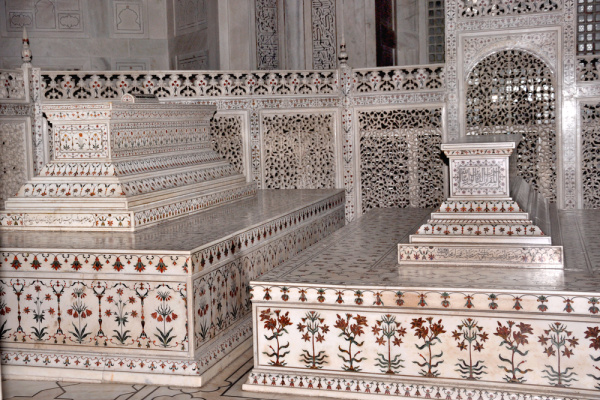
The cenotaphs in the top chamber
Towards the end of his life, Shah Jahan was overthrown by his son, Aurangzeb, who placed him under house arrest at Agra Fort. From here Shah Jahan would gaze at his wife’s mausoleum.
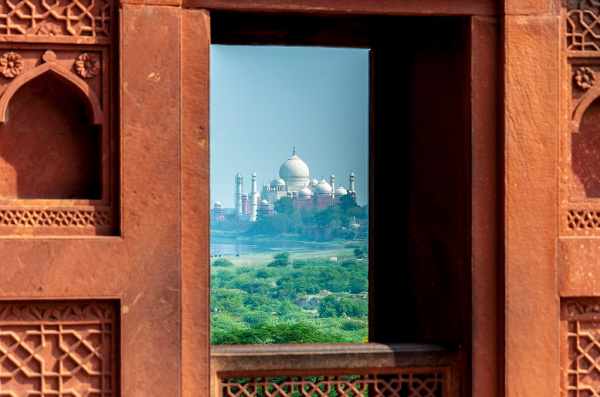
View of the Taj Mahal from Agra Fort
In 1666, Shah Jahan passed away. The Taj Mahal had been designed for Mumtaz Mahal alone, but after his father’s death Aurangzeb did not want to go to the effort of building a tomb for him, and he ordered that his father be interred in the Taj Mahal. Thus the lovers would now lie together for eternity.
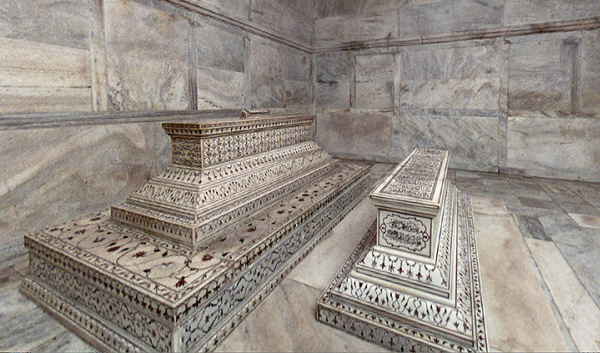
The true sarcophagi in the crypt
Today, visitors from around the world come to this beautiful and soulful monument, which was recently named one of the New Seven Wonders of the World. The white tomb is the centrepiece, of course, with its huge dome framed by elegant minarets, and around it are other structures of interest, like the Kau Ban Mosque, the guesthouse and the Great Gate, made from red sandstone.
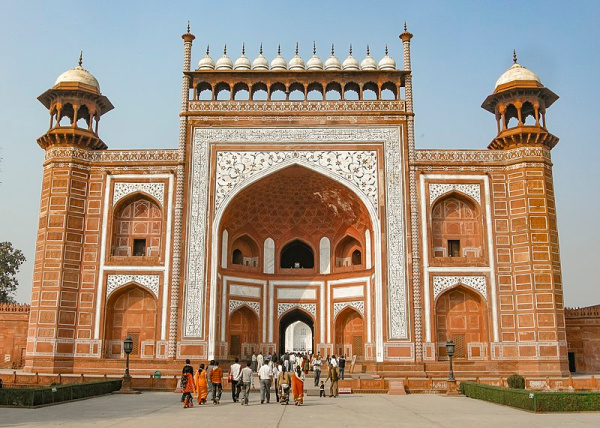
The Great Gate, on which is written: ‘O Soul, thou art at rest. Return to the Lord at peace with Him, and He at peace with you.’
The formal gardens are an integral part of the Taj Mahal. Great attention was paid to their design; sadly, some of this design was changed by the British during their rule, but the gardens remain very lush and green and attractive. The reflecting pool creates a particularly striking effect, a dreamy mirror twin of the ethereal monument.

The reflecting pool
The poet Rabindranath Tagore, winner of the Nobel Prize for Literature in 1913, described the Taj Mahal as a ‘teardrop on the cheek of eternity’. There are many great monuments in the world, but none, I think, that so beautifully represent loving devotion. May we all be loved like Mumtaz Mahal.

Picture credits: 1) Olena Tur/Shutterstock; 2) Chester Beatty Library, Dublin; 3) V&A Museum, London; 4) Ahsan Sheikh/Shutterstock; 5) A Ghosh/Wikipedia; 6) William Donelson/Wikipedia; 7) Matthew T Rader/Wikipedia; 8) Olena Tur/Shutterstock; 9) Belikova Oksana/Shutterstock.
Thanks for sharing this information. I have read some before. What is new is the use of the title Shah. I didn’t realize it was a general Muslim term. I thought it only applied to Iran. Does this imply that some Persians ruled in India?
The Mughals were heavily influenced by the Persians, I think.